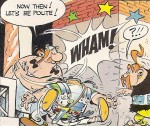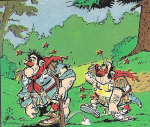 I’m sure we can all agree that it’s high time brain surgeons stopped screwing around and finally dedicated their time to worthy pursuits, namely a thorough investigation of the causes, nature and ethnic breakdown of traumatic brain injuries in Asterix books. A team of researchers from the Department for Neurosurgery of Heinrich-Heine-University in Düsseldorf, Germany have published the results of their study in Acta Neurochirurgica: The European Journal of Neurosurgery. The full clinical article is available for subscribers (or regular people like me who happen to know one) here.
I’m sure we can all agree that it’s high time brain surgeons stopped screwing around and finally dedicated their time to worthy pursuits, namely a thorough investigation of the causes, nature and ethnic breakdown of traumatic brain injuries in Asterix books. A team of researchers from the Department for Neurosurgery of Heinrich-Heine-University in Düsseldorf, Germany have published the results of their study in Acta Neurochirurgica: The European Journal of Neurosurgery. The full clinical article is available for subscribers (or regular people like me who happen to know one) here.
 Out of the 34 total Asterix books, the research team identified 704 traumatic brain injuries (TBIs). The injuries were assessed according to their severity using the Glasgow coma scale to rate a variety of post-trauma symptoms like subgaleal swelling, aka large bruised bumps on the noggin, periorbital ecchymoses, aka “raccoon eyes,” and paresis of the hypoglossal nerve, aka an outstretched tongue sticking out the side of the mouth. I could find no cool neurological term for tweeting birds and circling stars, however, which was a disappointment.
Out of the 34 total Asterix books, the research team identified 704 traumatic brain injuries (TBIs). The injuries were assessed according to their severity using the Glasgow coma scale to rate a variety of post-trauma symptoms like subgaleal swelling, aka large bruised bumps on the noggin, periorbital ecchymoses, aka “raccoon eyes,” and paresis of the hypoglossal nerve, aka an outstretched tongue sticking out the side of the mouth. I could find no cool neurological term for tweeting birds and circling stars, however, which was a disappointment.
Among the 704 identified cases of brain injury, the largest group was composed of Romans (n=450, 63.9%, Fig. 1a, Table 1). Thereof, most characters were members of the Roman imperial army (n=414), as troopers (n=365; 88.2%) or commissioned officers (n=49; 11.8%). Furthermore, 120 cases of head-injured Gaulish citizens were identified, as well as 21 head-injured pirates. The remaining head-injury victims had various sociocultural backgrounds, in that they were Belgians, Britons, Egyptians, Indians, native Americans, Normans, Swiss or Vikings (summarized in Fig. 1b). Also, four extraterrestrial characters suffered from TBI.
Not surprisingly, Gauls caused the vast majority of TBI (n=614, 87.1%). Alone, Asterix and Obelix were responsible for more than half of the detected TBIs (n=406, 57.6%). In contrast, 32 head injuries (4.5%) were caused by Romans and only one by a pirate.
Protective helmets were worn in most instances of traumatic brain injury (70.5%), understandable given the preponderance of armored Romans getting whupped, but were of dubious effectiveness since they often flew off the victims’ heads during a thumping. Out of 497 cases of brain injury sustained while wearing a helmet, the protective gear was lost in 436 of them. That’s an 87.7% helmet loss rate. Interestingly, the loss of the helmet did result in more cases of tongue-sticking-out, but not in more instances of giant goose eggs.
 Then there’s the matter of the doping agent. A performance enhancing drug known as “magic potion” was a significant factor in the severity of the brain injuries. Doubtless its exclusive use by the Gauls, in particular Asterix and Obelix, the latter of whom fell into a cauldron of said doping agent when he was a baby, is a major contributor to the preponderance of Roman victims. The “magic potion” also has a secondary usage as a curative. When administered after a traumatic brain injury, the victim is instantly healed.
Then there’s the matter of the doping agent. A performance enhancing drug known as “magic potion” was a significant factor in the severity of the brain injuries. Doubtless its exclusive use by the Gauls, in particular Asterix and Obelix, the latter of whom fell into a cauldron of said doping agent when he was a baby, is a major contributor to the preponderance of Roman victims. The “magic potion” also has a secondary usage as a curative. When administered after a traumatic brain injury, the victim is instantly healed.
The good news is through all this devastation of the poor, underpowered Romans and other antis, none of the traumatic brain injuries in Asterix books have ever resulted in death or even long-term impairment. The researchers point out that this highly favorable outcome is remarkable given the limited therapeutic tools in 50 B.C.
